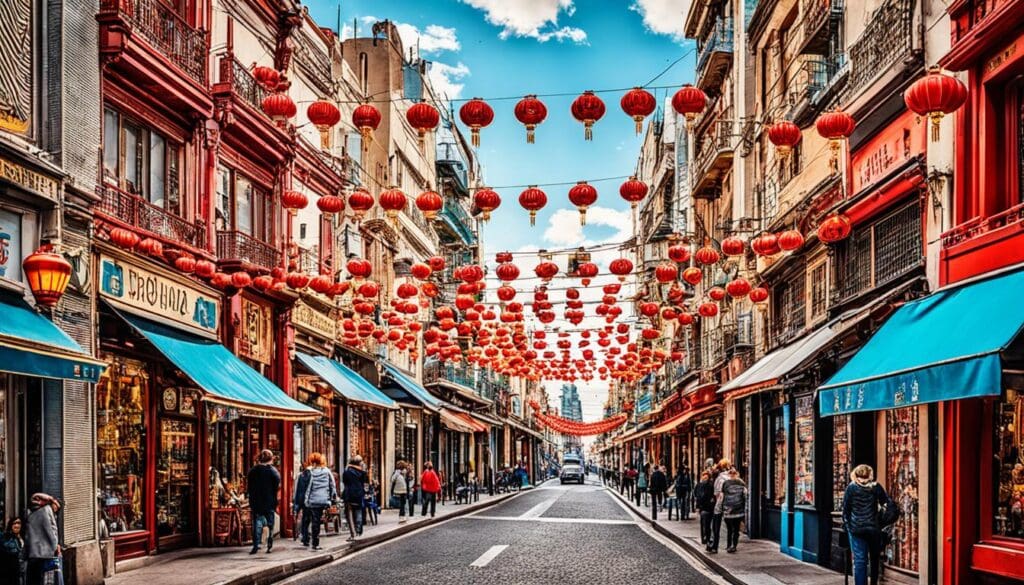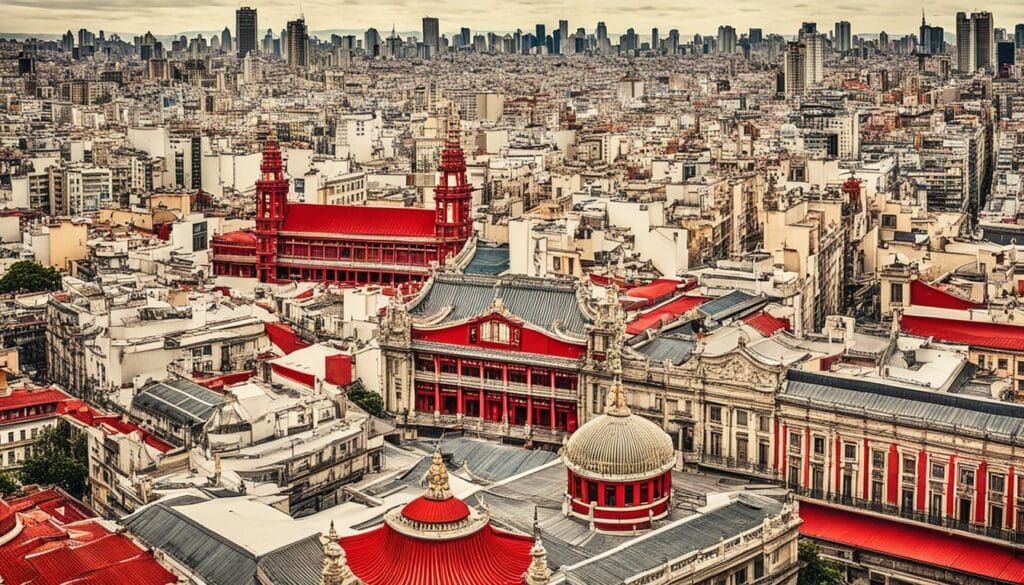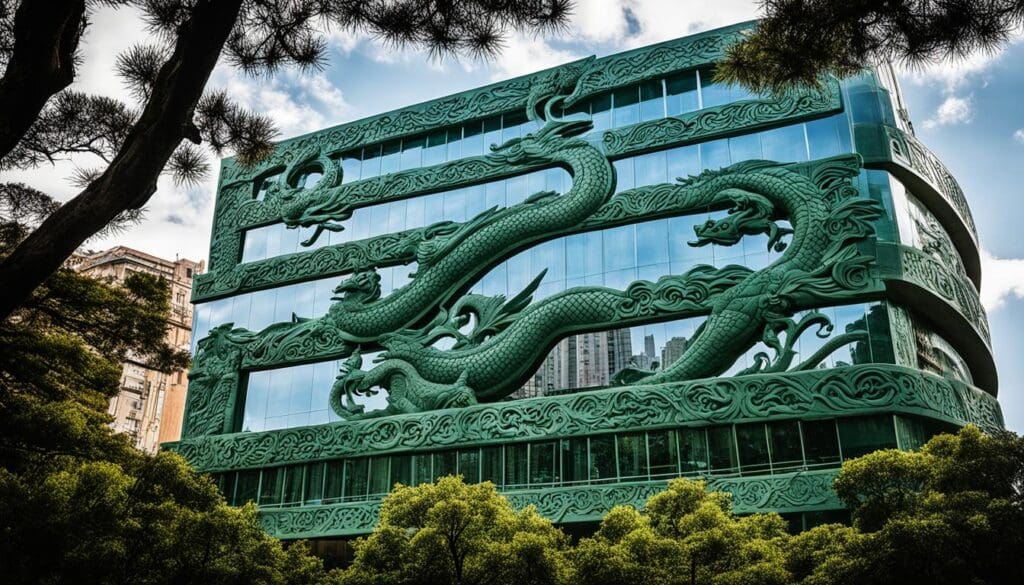Did you know that the historical connections between Ancient China and Buenos Aires can be traced back through the ancient trade routes that connected East Asia to the Americas? This cultural exchange between two ancient civilizations has left a lasting legacy in the heart of Buenos Aires. The city's symbols and architecture bear witness to the influence of Ancient China, creating a unique and captivating atmosphere for visitors and locals alike.
Historical Connections Between Ancient China and Buenos Aires
The historical connections between Ancient China and Buenos Aires can be traced back to the ancient trade routes that connected East Asia to the Americas. These trade routes served as conduits for the exchange of goods, ideas, and knowledge between the two regions, fostering a rich cultural exchange that influenced the architecture and symbols seen in Buenos Aires today.
Spanish Your Spanish Classes in Buenos Aires Today
The trade routes linking Ancient China and Buenos Aires facilitated the flow of silk, ceramics, spices, and other luxurious commodities from China to the Americas. Along with these material goods, ideas and knowledge also traveled, resulting in the infusion of Chinese culture and heritage into the fabric of Buenos Aires.
One example of the cultural exchange is the profound influence of Chinese architecture on the cityscape of Buenos Aires. The arrival of Chinese immigrants during the late 19th and early 20th centuries brought with them the expertise in traditional Chinese architecture, which found its expression in the construction of temples, cultural centers, and other notable buildings.
The image below displays a Chinese-inspired architectural masterpiece in Buenos Aires:
The integration of Ancient Chinese architectural elements in Buenos Aires is striking. Elaborate rooftops, intricate carvings, and vibrant color schemes reminiscent of traditional Chinese architecture can be found in iconic structures such as the Confucius Institute and the Chinese Cultural Center.
To further illustrate the historical connections between Ancient China and Buenos Aires, the table below highlights key points of cultural exchange and influence:
| Trade Routes | Cultural Exchange | Influence on Architecture |
|---|---|---|
| Ancient trade routes connected East Asia to the Americas | Exchange of goods, ideas, and knowledge | Integration of traditional Chinese architectural elements |
| Flow of silk, ceramics, and spices from China | Infusion of Chinese culture and heritage | Creation of temples, cultural centers, and other iconic buildings |
| Arrival of Chinese immigrants in Buenos Aires | Transmission of expertise in Chinese architecture | Incorporation of Chinese architectural styles in cityscape |
The historical connections between Ancient China and Buenos Aires have left an indelible mark on the city, shaping its cultural identity and enhancing its architectural charm. The enduring influence of Ancient China can still be felt and appreciated by residents and visitors, serving as a testament to the power of cultural exchange and the interconnectedness of our global history.
Ancient Chinese Symbols in Buenos Aires
The influence of Ancient China can be seen in the symbols found throughout Buenos Aires. Chinese symbols such as dragons, pagodas, and lotus flowers are commonly used in the architecture and design of buildings, parks, and public spaces. These symbols not only add a unique aesthetic to the city but also serve as a representation of the historical and cultural connections between Ancient China and Buenos Aires.


The use of Chinese symbols in Buenos Aires is a testament to the long-standing cultural influence of Ancient China on the city. Dragons, known for their strength and power, are often incorporated into the design of buildings as decorative elements or as sculptures. Pagodas, with their distinct multi-tiered structures, can be found in various parks and public spaces, serving as landmarks and symbols of tranquility and spirituality. The lotus flower, a symbol of purity and enlightenment in Chinese culture, is often depicted in artwork and can be seen in city parks and gardens.
The presence of these symbols not only adds visual interest to Buenos Aires but also reflects the historical connections between Ancient China and the city. It is a testament to the cultural exchange and trade routes that connected East Asia to the Americas, allowing for the sharing of ideas, knowledge, and artistic traditions.
Ancient Chinese Symbols in Buenos Aires - Examples
| Symbol | Description |
|---|---|
| Dragon | A powerful and mythical creature often depicted in Chinese architecture and artwork. Represents strength, power, and good fortune. |
| Pagoda | A multi-tiered tower with its roots in Chinese Buddhist architecture. Symbolizes spirituality and enlightenment. |
| Lotus Flower | A sacred flower in Chinese culture, representing purity, enlightenment, and rebirth. Often depicted in artwork and found in parks and gardens. |
These examples showcase how Ancient Chinese symbols have become ingrained in the cultural fabric of Buenos Aires, adding depth and meaning to the city's architectural landscape. They are a testament to the enduring influence of Ancient China on Buenos Aires and serve as a reminder of the rich historical connections between these two regions.
East Asian Architecture in Buenos Aires
The architecture of Buenos Aires beautifully reflects the strong influence of East Asian aesthetics, particularly those stemming from Ancient China. The city's buildings showcase intricate designs, ornate rooftops, and colorful decorations reminiscent of traditional Chinese architecture. This architectural style is a testament to the cultural exchange and mutual influence between Ancient China and Buenos Aires.
One notable example of East Asian architecture in Buenos Aires is the Confucius Institute. The building's exterior features elaborate carvings and vibrant colors that mirror the craftsmanship seen in ancient Chinese structures. The Confucius Institute not only serves as a center for Chinese language and cultural studies but also stands as a physical representation of Buenos Aires' rich multicultural heritage.
Another significant architectural landmark is the Chinese Cultural Center. This institution celebrates the contributions of the Chinese community in Buenos Aires and showcases distinctive elements of East Asian architecture. From the pagoda-style roofs to the detailed stone carvings, the center pays homage to Ancient China's architectural legacy in the city.
These examples of East Asian architecture in Buenos Aires demonstrate the enduring impact of Ancient China on the city's aesthetic landscape. The vibrant colors, intricate details, and ornate designs create a visual delight for locals and visitors alike, while serving as a reminder of the historical and cultural connections between Ancient China and Buenos Aires.
Impact on Buenos Aires' Cultural Identity
The influence of Ancient China has had a profound impact on the cultural identity of Buenos Aires. The architectural styles and symbols found throughout the city serve as a reminder of the historical connections between Ancient China and Buenos Aires. This cultural exchange has not only shaped the physical landscape of the city but has also contributed to the cultural diversity and global connections that are characteristic of Buenos Aires today.
The presence of Ancient Chinese symbols in Buenos Aires reflects the enduring legacy of cultural exchange between the two regions. These symbols, such as dragons, pagodas, and lotus flowers, can be found in the design of buildings, parks, and public spaces. They not only add a unique aesthetic to the city but also symbolize the historical and cultural ties with Ancient China.
The incorporation of East Asian architectural styles in Buenos Aires further enhances the city's cultural identity. Buildings inspired by traditional Chinese design, with ornate rooftops, intricate carvings, and vibrant decorations, are scattered throughout the city. Examples include the Confucius Institute and the Chinese Cultural Center, which showcase the rich heritage of Ancient China in Buenos Aires.
This fusion of Ancient Chinese symbols and architecture has contributed to the cultural diversity and global connections that define Buenos Aires. The city has become a melting pot of different cultures and histories, with Ancient China playing a significant role in shaping its identity.
To visually appreciate the impact of Ancient China on Buenos Aires, take a moment to admire this image:


An Example of Ancient Chinese Influence in Buenos Aires
| Building | Description |
|---|---|
| Confucius Institute | A cultural and educational institution that promotes Chinese language and culture. The building's design features traditional Chinese architecture with curved roofs, intricate patterns, and vibrant colors. |
| Chinese Cultural Center | Another center dedicated to promoting Chinese culture. The building draws inspiration from traditional Chinese architecture, incorporating elements such as dragon motifs and intricate woodwork. |
| Districts with Chinese Influence | Areas like Chinatown, known as "Barrio Chino," showcase the cultural influence of Ancient China. Visitors can explore Chinese markets, enjoy authentic Chinese cuisine, and experience cultural festivals. |
The preservation and celebration of the legacy of Ancient China in Buenos Aires not only pays homage to the historical connections between the two regions but also contribute to the city's vibrant cultural landscape. The fusion of Ancient Chinese symbols and architecture with the multicultural fabric of Buenos Aires exemplifies the city's rich cultural diversity and global connections.
Historical Significance of Ancient China in Buenos Aires
The historical significance of Ancient China in Buenos Aires is of utmost importance, as it played a crucial role as a prominent cultural exchange hub. The trade routes that connected East Asia to the Americas served as conduits for the exchange of goods, ideas, and knowledge between the two regions. This cultural exchange not only shaped the architectural styles and symbols seen throughout Buenos Aires but also contributed significantly to the growth and development of the city.
Ancient China's historical significance can be best understood through the lens of cultural exchange. As merchants and explorers traversed the trade routes, they brought with them not only material goods but also ideas, philosophies, and artistic expressions. This exchange of cultural elements provided invaluable insights into various aspects of Ancient Chinese civilization, including its architecture, symbolism, and way of life.
The cultural influence of Ancient China can be seen in the fusion of architectural styles in Buenos Aires. Elements such as the iconic curved rooftops, intricate carvings, and vibrant colors reflect the rich heritage of Ancient Chinese architecture. Notably, buildings like the Confucius Institute and the Chinese Cultural Center exhibit East Asian architectural characteristics, paying homage to the historical connections between Ancient China and Buenos Aires.
Furthermore, the symbols derived from Ancient China that adorn the city's landscape further emphasize the historical significance of this cultural exchange. Dragons, pagodas, and lotus flowers, amongst others, can be found in the architecture, parks, and public spaces of Buenos Aires. These symbols not only add visual charm to the city but also serve as a testament to the enduring ties between Ancient China and Buenos Aires.
It is the historical significance of Ancient China in Buenos Aires that has helped shape the city's cultural identity and global connections. The influence of Ancient Chinese civilization has reinforced the diverse and multicultural nature of Buenos Aires, highlighting the city's openness to embracing different cultures and civilizations. This legacy contributes to Buenos Aires' allure as a vibrant and cosmopolitan metropolis.
To fully appreciate the historical significance of Ancient China in Buenos Aires, it is crucial to explore and engage with the architectural charms and cultural landmarks that bear witness to this enduring cultural exchange. The city offers numerous opportunities for cultural exploration, including visits to Chinese temples, cultural centers, and exhibitions that showcase the impact of Ancient China on Buenos Aires.
It is essential to recognize and preserve the legacy of Ancient China in Buenos Aires to maintain the city's cultural identity and historical connections. Efforts to protect and restore Chinese-inspired architecture, combined with the promotion of cultural events and activities, ensure that this heritage continues to be cherished and celebrated. By safeguarding and appreciating the historical significance of Ancient China in Buenos Aires, we not only honor the past but also contribute to the rich tapestry of the city's cultural mosaic.
Ancient Chinese Influence in Buenos Aires: A Comparative Table of Symbols
| Ancient Chinese Symbol | Buenos Aires Representation |
|---|---|
| Dragon | Seen in the architectural details of buildings and as decorative elements in public spaces |
| Pagoda | Architectural structures reminiscent of Ancient Chinese pagodas |
| Lotus Flower | Symbolic flower depicted in parks and gardens throughout the city |
| Phoenix | Represented in various forms of art and interior design |
| Koi Fish | Found in ornamental ponds and water features |
The table above provides a comparative overview of some of the ancient Chinese symbols and their representation in Buenos Aires. These symbols not only highlight the historical significance of Ancient China in the city but also demonstrate the enduring influence of this cultural exchange.
Exploring Ancient Chinese Influence in Buenos Aires
When visiting Buenos Aires, one cannot miss the opportunity to explore the ancient Chinese influence that has shaped the city's cultural heritage and architectural charms. From magnificent Chinese temples to vibrant cultural centers, there are numerous avenues to immerse oneself in the historical connections between Ancient China and Buenos Aires.
One of the highlights of cultural exploration in Buenos Aires is visiting the Chinese temples scattered across the city. These temples, such as the Linhong Temple and the Tian Hou Temple, not only serve as places of worship but also showcase the intricate architectural details and traditional Chinese designs. Visitors can marvel at the ornate roofs, vibrant colors, and delicate carvings that reflect the rich cultural heritage of Ancient China.
For those looking to delve deeper into the historical connections, the Chinese cultural centers in Buenos Aires provide a wealth of knowledge and experiences. The Confucius Institute, for example, offers language classes, cultural workshops, and exhibitions that provide insights into the history, traditions, and customs of Ancient China. These cultural centers serve as a hub for learning and celebrating the cultural exchange between Ancient China and Buenos Aires.
An integral part of exploring the ancient Chinese influence is admiring the intricate details of Chinese-inspired architecture scattered throughout the city. The Chinese Cultural Center, with its traditional pagoda-style structure and beautiful garden, is a prime example of the architectural charms that showcase the fusion of Ancient Chinese and Argentine aesthetics. The harmonious blend of colors, patterns, and symbols creates a unique visual experience that transports visitors to another time and place.


As visitors embark on their journey to explore the ancient Chinese influence in Buenos Aires, they will not only discover the architectural marvels but also gain a deep appreciation for the cultural exchange and historical connections that have shaped this vibrant city. The allure of Ancient China can be seen and felt in every corner, offering a truly immersive and enriching experience for cultural enthusiasts and history buffs alike.
Preserving the Legacy of Ancient China in Buenos Aires
Preserving the legacy of Ancient China in Buenos Aires is of utmost importance in order to maintain the cultural identity and historical connections of the city. Efforts are continuously being made to protect and restore Chinese-inspired architecture, as well as to promote cultural events and activities that celebrate the rich cultural exchange between Ancient China and Buenos Aires.
The preservation of architectural heritage plays a crucial role in honoring the historical significance of Ancient China in Buenos Aires. By maintaining and safeguarding Chinese-influenced buildings, such as temples and cultural centers, the city can offer a tangible connection to its past and ensure that future generations can appreciate the architectural gems that contribute to its unique charm.
Additionally, cultural events and activities provide opportunities for locals and visitors alike to immerse themselves in the cultural exchange that took place between Ancient China and Buenos Aires. These events showcase traditional customs, rituals, and performances, further strengthening the appreciation for and understanding of the city's cultural diversity.
Efforts in heritage preservation not only protect the physical structures but also foster a deep appreciation for the cultural identity created by the historical connections between Ancient China and Buenos Aires. By acknowledging and celebrating this heritage, the city can embrace its global connections and enrich its cultural fabric.
Preservation Initiatives in Buenos Aires
Buenos Aires is home to various initiatives that strive to preserve the legacy of Ancient China in the city:
- The Heritage Preservation Society of Buenos Aires actively works towards restoring and maintaining Chinese-inspired architectural landmarks. Their conservation efforts include upkeep, renovation, and restoration projects to ensure the long-term preservation of these sites.
- The annual Chinese Cultural Festival brings together the local Chinese community and Buenos Aires residents to celebrate Chinese heritage through art, music, dance, and cuisine. This vibrant event highlights the importance of preserving Ancient China's legacy in the city.
- The Buenos Aires Confucius Institute offers language courses, cultural workshops, and exhibitions, serving as a valuable resource for anyone interested in exploring the rich cultural heritage of Ancient China in Buenos Aires.
Preserving Symbols and Traditions
In addition to architectural preservation, focuses are also placed on safeguarding the symbols and traditions associated with Ancient China in Buenos Aires. These efforts ensure that the essence of Ancient China's cultural influence remains alive:
| Symbol | Meaning | Examples in Buenos Aires |
|---|---|---|
| Dragon | A symbol of power, strength, and good luck | Dragon statues at the Chinese Cultural Center |
| Pagoda | A representation of Buddhist architecture and spiritual connection | The Pagoda at the Japanese Garden |
| Lotus Flower | A symbol of purity, enlightenment, and rebirth | The Lotus Bridge at the Rose Garden |
The preservation of these symbols ensures that Ancient China's cultural identity continues to be represented and appreciated in Buenos Aires, contributing to a sense of cultural diversity and enrichment in the city.
Buenos Aires recognizes the historical and cultural significance of Ancient China's influence, and through ongoing preservation efforts, the city ensures that the legacy of Ancient China lives on, fostering a deeper understanding and appreciation of its global connections and cultural heritage.
Conclusion: The Enduring Impact of Ancient China in Buenos Aires
The historical connections and cultural exchange between Ancient China and Buenos Aires have left a lasting impact on the city's symbols and architecture. The influence of Ancient China can be seen in the use of East Asian symbols such as dragons, pagodas, and lotus flowers, which add a unique aesthetic to Buenos Aires. These symbols not only showcase the historical connections between the two regions but also contribute to the cultural identity of the city.
The architectural styles found in Buenos Aires also reflect the enduring impact of Ancient China. The ornate rooftops, intricate carvings, and colorful decorations reminiscent of traditional Chinese architecture can be seen in prominent buildings like the Confucius Institute and the Chinese Cultural Center. These architectural charms serve as a testament to the cultural exchange that has shaped Buenos Aires over the years.
Preserving the legacy of Ancient China is vital to maintain the cultural identity and historical connections of Buenos Aires. Efforts are being made to protect and restore Chinese-inspired architecture, ensuring that future generations can appreciate and value this important heritage. Cultural events and activities that celebrate the enduring impact of Ancient China also help to keep this legacy alive, promoting a deeper understanding of the historical connections that have shaped the city.




